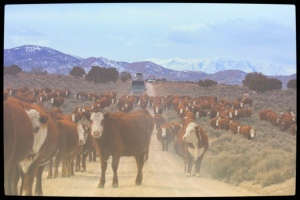By Brian Ertz as published in The Wildlife News
“The BLM can no longer remain in denial …”

Privately
owned welfare cattle being herded into Antelope Complex, Feb 2011, as
BLM wild horse roundup is going on at the same time. ~ photo by Terry
Fitch
The “Rangeland Inventory, Monitoring and Evaluation Report for Fiscal Year 2011” covers BLM allotments in Arizona, California, Colorado, Idaho, Montana, Nevada, New Mexico, North Dakota, Oregon, South Dakota, Utah, Washington and Wyoming. The report totals BLM acreage failing to meet rangeland health standards in measures such as water quality, watershed functionality and wildlife habitat:
- Almost 40% of BLM allotments surveyed since 1998 have failed to meet the agency’s own required land health standards with impairment of more than 33 million acres, an area exceeding the State of Alabama in size, attributed to livestock grazing;
- Overall, 30% of BLM’s allotment area surveyed to date suffers from significant livestock-induced damage, suggesting that once the remaining allotments have been surveyed, the total impaired area could well be larger than the entire State of Washington; and
- While factors such as drought, fire, invasion by non-native plants, and sprawl are important, livestock grazing is identified by BLM experts as the primary cause (nearly 80%) of BLM lands not meeting health standards.
This is to say nothing about the actual condition of public lands, which some public oversight organizations maintain to be in much worse condition than is reported due to overwhelming pressure on agency employees to overlook grazing impacts or attribute them to something else.
Last November, PEER filed a scientific integrity complaint that BLM had directed scientists to exclude livestock grazing as a factor in changing landscapes as part of a $40 million study, the biggest such effort ever undertaken by BLM. The complaint was referred to a newly appointed Scientific Integrity Officer for BLM but there are no reports of progress in the agency’s self-investigation in the ensuing months.
At the same time, BLM range evaluations, such as this latest one, use ambiguous categories that mask actual conditions, employing vague terms such as “making significant progress” and “appropriate action has been taken to ensure significant progress” that obscure damage estimates and inflate the perception of restoration progress. For example, in 2001 nearly 60% of BLM lands (94 million acres, an area larger than Montana) consisted of grazing allotments that were supposed to be managed to “improve the current resource condition” – a number that has stayed unchanged for a decade.
Efforts to demand improved condition for imperiled species, like sage grouse, are met with state and local attempts to influence federal policy by recommending management that ignores the impacts of livestock grazing and BLM’s own politicized attempts to forestall any meaningful management changes to livestock grazing for decades.
“Commercial livestock operations are clearly a major force driving degradation of wild places, jeopardy to wildlife, major loss of water quality and growing desertification throughout the American West,” Stade added, while noting that BLM has historically been dominated by livestock interests. “The BLM can no longer remain in denial on the declining health of our vast open range.”
Meanwhile, Livestock interests in Washington DC continue to push for less environmental analysis, less public involvement in grazing decisions, and to double the length of grazing permits with the Grazing
Click (HERE) to visit The Wildlife News and to Comment
- BLM Nat. Wild Horse and Burro “Slaughter” Advisory Board Meets Today (rtfitchauthor.com)
- BLM Puts Public in Holding (rtfitchauthor.com)
- TODAY: National Wild Horse and Burro Call-In Protest to “Cull Callie” from BLM Advisory Board (rtfitchauthor.com)
- Obama’s BLM “Slaughter” Advisory Board Shows True Colors on First Day (rtfitchauthor.com)
- Callie Hendrickson: “Pro-slaughter” Appointee to BLM Wild Horse Board Draws Protests (rtfitchauthor.com)
- BLM Officially Confirms Attack on Cloud’s Herd is Eminent (rtfitchauthor.com)
- Some Horse Sense at Last? (rtfitchauthor.com)









No comments:
Post a Comment